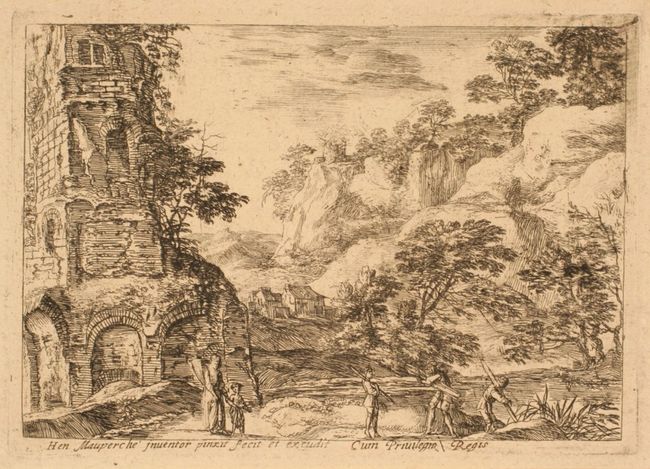Paysage à la tour en ruines - Mauperché Henri - Mauperché Henri
Domaine
Arts graphiques
Peintre-graveur
Mauperché Henri
- Lieu de naissanceParis
- Date de naissance1602 : vers
- Lieu de décèsParis
- Date de décès1686
- Notice biographiqueFrench painter and printmaker. He may have studied under Daniel Rabel at some period before 1634, in which year he travelled to Rome with Louis Boullogne (i). There, almost certainly, they became acquainted with Jean Blanchard, Sébastien Bourdon and Herman van Swanevelt. Mauperché was back in Paris in 1639, working with Blanchard for Armand-Jean du Plessis, Cardinal de Richelieu, at the Palais-Royal; the contract (12 March 1639) for the works to be undertaken mentions topographical views and landscapes with ruins, a contract in which Mauperché is described as Peintre Ordinaire du Roy. About 1646–7 he painted a Landscape with Traveller (Paris, Louvre) as part of the commission to decorate the interiors of the Cabinet de l’Amour at the Hôtel Lambert, Paris, where he worked alongside Swanevelt, Jan Asselijn and Pierre Patel (i). He was married for the first time in 1647, with Blanchard as one of the witnesses. In 1648 he was among the group of artists accepted (agréé) by the Académie Royale de Peinture et de Sculpture. In 1654 he engraved his only dated work, the Plan of Liancourt (see Robert-Dumesnil, no. 51), a bird’s-eye view of the château and gardens (destr.) in Oise owned by the du Plessy family. The following year he became a professor at the Académie Royale.
During the 1660s Mauperché’s commissions included eight landscapes (1660; untraced) for the apartments in the Louvre, Paris, of Louis XIV’s wife, Maria-Theresa, and fourteen large landscapes for Anne of Austria’s Grand Cabinet at the château of Fontainebleau, on which he worked with Jean Cotelle; only two survive, the Pilgrims at Emmaus and Christ and the Woman of Samaria (both 1663; Sofia, N. Archaeol. Mus.). Among his other works are a number depicting religious subjects, including the Landscape with Tobias and the Angel (Lisieux, Mus. Vieux-Lisieux) and the Rest on the Flight into Egypt (1671; Paris, Louvre). Mauperché’s careful attention to the effects of atmospheric perspective in these and other pictures is the result of his strong links with other French landscape painters in Paris during the late 1640s, in particular Pierre Patel (i), with whose works some by Mauperché have occasionally been confused.
Mauperché is best known for his complex and spirited engravings (some 50 survive), for which he was dubbed ‘the French Swanevelt’. Apart from the bird’s-eye view of Liancourt, none is dated, but most were made during the period in which he lived in the Ile Saint-Louis (1639–56); they include the series of six prints each of the Life of the Virgin (rd 16–21), the Story of Tobias (rd 2–7) and the Prodigal Son (rd 10–15). This period was one of intense stylistic experiment for Mauperché, in the course of which he absorbed the classicizing style of the years of Anne of Austria’s Regency, leading to an emphasis on perspective and balanced compositions; he thus came close to the compositional formulae of both Patel and Laurent de La Hyre. This general quest for the mood of the time was enriched by Mauperché’s own individual touches.
BIBLIOGRAPHY
A.-P.-F. Robert-Dumesnil: Le Peintre-graveur français (1835–71) [rd]
F. Engerand: Inventaires des collections de la couronne: Inventaire des tableaux du Roy rédigé en 1709–1710 par Nicolas Bailly (Paris, 1899)
J.-M. Barielle: Henri Mauperché (1602–1685) (diss., U. Paris IV, 1979)
Article rédigé par Nathalie Coural
Groveart 2006.
- 1634-1639 : ROME
Il accompagne Louis Boullogne le Vieux à Rome, et est en contact avec Sébastien Bourdon et le groupe des bambocheurs.
- 1639 : de retour à Paris ; décor de la salle des gardes et de l'antichambre de l'hôtel du cardinal de Richelieu
- 1646-1647 : décoration du registre inférieur du Cabinet de l'Amour de l'hôtel Lambert, en collaboration avec Pierre Patel l'Ancien, Jean Asselyn et Herman Swanevelt
- 1664 : décoration de l'Appartement de la Reine à Fontainebleau
Date de création
1687 : avant
Lieu
Paris
Editeur
Mauperché Henri
- Lieu de naissanceParis
- Date de naissance1602 : vers
- Lieu de décèsParis
- Date de décès1686
- Notice biographiqueFrench painter and printmaker. He may have studied under Daniel Rabel at some period before 1634, in which year he travelled to Rome with Louis Boullogne (i). There, almost certainly, they became acquainted with Jean Blanchard, Sébastien Bourdon and Herman van Swanevelt. Mauperché was back in Paris in 1639, working with Blanchard for Armand-Jean du Plessis, Cardinal de Richelieu, at the Palais-Royal; the contract (12 March 1639) for the works to be undertaken mentions topographical views and landscapes with ruins, a contract in which Mauperché is described as Peintre Ordinaire du Roy. About 1646–7 he painted a Landscape with Traveller (Paris, Louvre) as part of the commission to decorate the interiors of the Cabinet de l’Amour at the Hôtel Lambert, Paris, where he worked alongside Swanevelt, Jan Asselijn and Pierre Patel (i). He was married for the first time in 1647, with Blanchard as one of the witnesses. In 1648 he was among the group of artists accepted (agréé) by the Académie Royale de Peinture et de Sculpture. In 1654 he engraved his only dated work, the Plan of Liancourt (see Robert-Dumesnil, no. 51), a bird’s-eye view of the château and gardens (destr.) in Oise owned by the du Plessy family. The following year he became a professor at the Académie Royale.
During the 1660s Mauperché’s commissions included eight landscapes (1660; untraced) for the apartments in the Louvre, Paris, of Louis XIV’s wife, Maria-Theresa, and fourteen large landscapes for Anne of Austria’s Grand Cabinet at the château of Fontainebleau, on which he worked with Jean Cotelle; only two survive, the Pilgrims at Emmaus and Christ and the Woman of Samaria (both 1663; Sofia, N. Archaeol. Mus.). Among his other works are a number depicting religious subjects, including the Landscape with Tobias and the Angel (Lisieux, Mus. Vieux-Lisieux) and the Rest on the Flight into Egypt (1671; Paris, Louvre). Mauperché’s careful attention to the effects of atmospheric perspective in these and other pictures is the result of his strong links with other French landscape painters in Paris during the late 1640s, in particular Pierre Patel (i), with whose works some by Mauperché have occasionally been confused.
Mauperché is best known for his complex and spirited engravings (some 50 survive), for which he was dubbed ‘the French Swanevelt’. Apart from the bird’s-eye view of Liancourt, none is dated, but most were made during the period in which he lived in the Ile Saint-Louis (1639–56); they include the series of six prints each of the Life of the Virgin (rd 16–21), the Story of Tobias (rd 2–7) and the Prodigal Son (rd 10–15). This period was one of intense stylistic experiment for Mauperché, in the course of which he absorbed the classicizing style of the years of Anne of Austria’s Regency, leading to an emphasis on perspective and balanced compositions; he thus came close to the compositional formulae of both Patel and Laurent de La Hyre. This general quest for the mood of the time was enriched by Mauperché’s own individual touches.
BIBLIOGRAPHY
A.-P.-F. Robert-Dumesnil: Le Peintre-graveur français (1835–71) [rd]
F. Engerand: Inventaires des collections de la couronne: Inventaire des tableaux du Roy rédigé en 1709–1710 par Nicolas Bailly (Paris, 1899)
J.-M. Barielle: Henri Mauperché (1602–1685) (diss., U. Paris IV, 1979)
Article rédigé par Nathalie Coural
Groveart 2006.
- 1634-1639 : ROME
Il accompagne Louis Boullogne le Vieux à Rome, et est en contact avec Sébastien Bourdon et le groupe des bambocheurs.
- 1639 : de retour à Paris ; décor de la salle des gardes et de l'antichambre de l'hôtel du cardinal de Richelieu
- 1646-1647 : décoration du registre inférieur du Cabinet de l'Amour de l'hôtel Lambert, en collaboration avec Pierre Patel l'Ancien, Jean Asselyn et Herman Swanevelt
- 1664 : décoration de l'Appartement de la Reine à Fontainebleau
Date de création
1687 : avant
Lieu
Paris
Désignation du bien
Paysage à la tour en ruines
Inscriptions / marques
Lettre
dans la marge inférieure
à gauche : Hen Mauperché jnuentor pinxit fecit et excudit Cum Priuilegio Regis.
Inscription
au verso
à l'encre : 12.
au crayon : Mauperché Henry 17è siècle / a gravé q.q- paysages.
Annotation
sur le montage
au crayon de la main du collectionneur Jacques Thuillier
Henri Mauperché. 1602-1686 / R.D. 39
Libellé
Gravure à l'eau-forte
Mesures
H. à la cuvette en mm : 112
L. à la cuvette en mm : 159
H. du montage en mm : 498
L. du montage en mm : 325
Description
A main gauche, la tour en ruine.
Bibliographie
Robert-Dumesnil (A.P.F.), Le peintre-graveur français ou Catalogue raisonné des estampes gravées par les peintres et les dessinateurs de l'école française. Ouvrage faisant suite au peintre-graveur de M. Bartsch, Paris, t.I, 1835.
Robert-Dumesnil (A.P.F.), Le peintre-graveur français ou Catalogue raisonné des estampes gravées par les peintres et les dessinateurs de l'école française. Ouvrage faisant suite au peintre-graveur de M. Bartsch, Paris, t.I, 1835.
R-D 39.
Herman Sandrine, Estampes françaises du XVIIe siècle. Une donation au musée des beaux-arts de Nancy, Editions du CTHS, Paris, 2008
Herman Sandrine, Estampes françaises du XVIIe siècle. Une donation au musée des beaux-arts de Nancy, Editions du CTHS, Paris, 2008
n°1410, p.405
Acquisition
1999.15 Donation Thuillier
Photographe
Cliché Ville de Nancy, P. Buren
Numéro d'inventaire
TH.99.15.1017
Sujet / thème
Paysage
Arbre
Plante
Homme
Femme
Village
Enfant
Ruines
Tour
Facettes
Cliquez sur un terme pour voir toutes les œuvres de nos collections associées à ce dernier.


